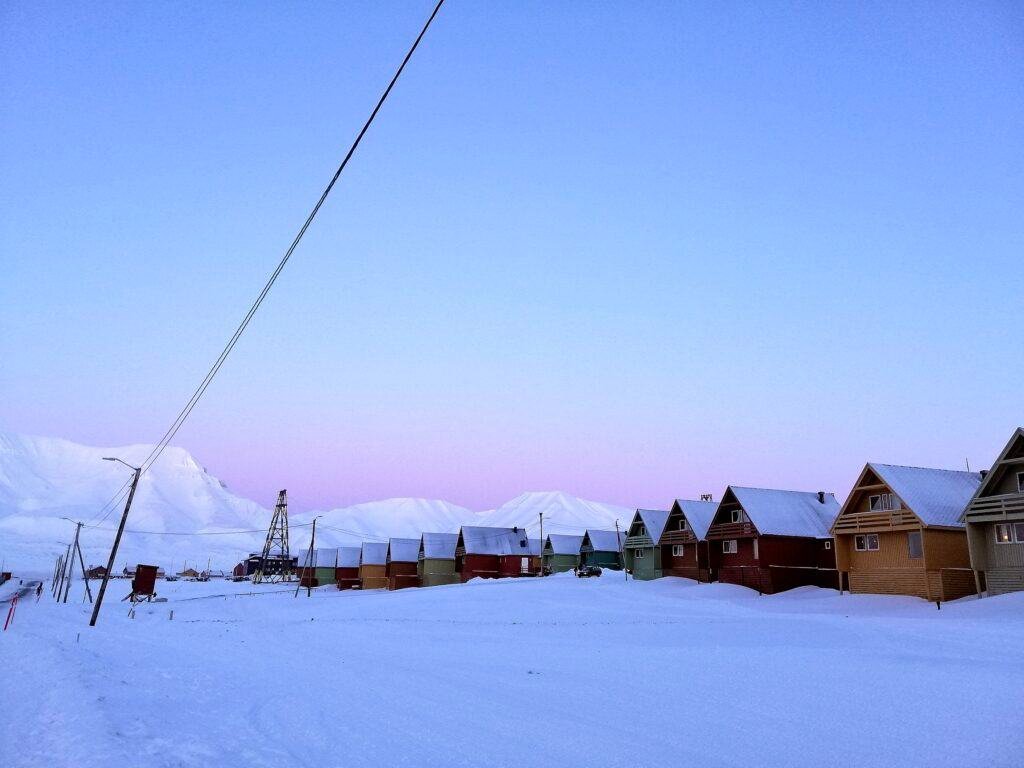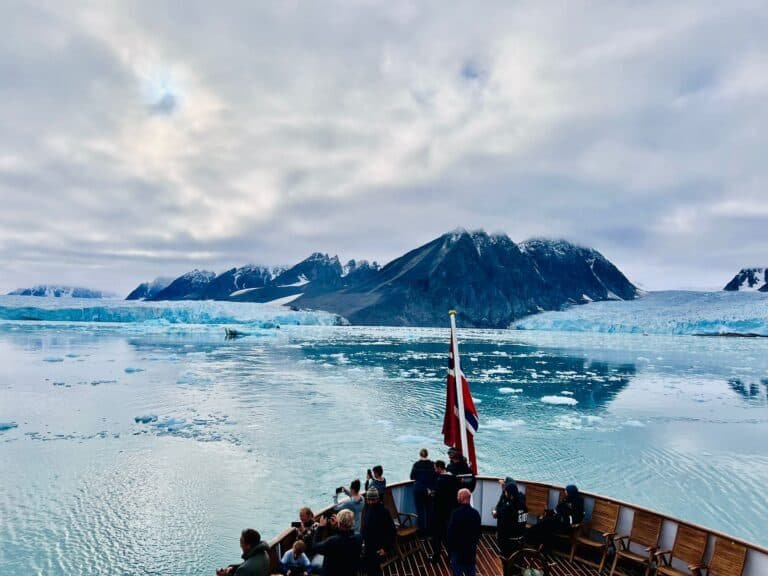Insider’s Guide: Top 10 Tips for Traveling to Longyearbyen

Greetings, Arctic adventurers! If you’re gearing up for a journey to Longyearbyen, the heart of Svalbard, you’re in for a treat. As someone who has called this place home for years, I’m excited to share insider tips that you won’t find in your average travel brochure.
For an extra slice of Arctic life, you can listen to my recent podcast guest appearance on Amateur Traveler with Chris, where I take the conversation even beyond these tips. I shared a more detailed insight on how to spend your days up here. If it is your first time visiting, read my article about the Svalbard Travel Guide for First-Time Visitors.
Now, let’s get to the nitty-gritty with practical advice that will make your trip as smooth and enjoyable as possible!
1. Master the Art of Layering
Layering isn’t just a fashion statement here; it’s a survival strategy. In Longyearbyen, the weather can swing from surprisingly mild to blisteringly cold within hours. Starting with moisture-wicking materials as your base layer, such as merino wool or synthetic fabrics, is crucial to keep sweat away from your skin. Mid-layers should insulate—think fleece or down jackets. Finally, your shell layer must be windproof and waterproof to withstand Svalbard’s biting winds and snow. And don’t overlook accessories—thermal socks, insulated gloves, a balaclava, and a warm hat are indispensable. Remember, it’s easier to shed a layer if you’re warm than to conjure one out of thin air if you’re cold.
2. Be Polar Bear Aware
Polar bears are a real and present danger outside Longyearbyen’s limits, so bear safety is paramount. Any venture beyond the settlement requires a means to scare off these majestic creatures. Before your trip, educate yourself on polar bear behavior. Always carry a rifle or flare gun—available for rent locally—and know how to use it. Most importantly, never travel alone in polar bear territory. Hiring a guide isn’t just for the extra company; it’s a safety necessity. These experts can spot signs of bears you would miss and have the experience to handle an encounter. Remember, while polar bears are beautiful, they are also unpredictable predators.
3. Tread Lightly
Our Arctic environment is breathtaking and brittle. The tundra’s mosses and lichens take decades to grow and can be destroyed with a single footstep. Stick to the established paths when hiking and always carry out what you carry. Littering is not just frowned upon; it can have severe ecological consequences. When viewing wildlife, use binoculars instead of approaching. Disturbing animals in their natural habitat can cause stress and long-term harm to their populations. By respecting these guidelines, you help preserve the beauty of Svalbard for future generations.
4. Stay on the Grid, Even Off the Grid
In the vast openness of the Arctic, your lifeline is communication. While Longyearbyen itself has good mobile coverage, it drops off sharply outside town. A satellite phone could be your best friend in the unlikely event of an emergency. Rent one from local outfitters and keep it charged and on your person at all times when you’re adventuring beyond the town’s borders. Additionally, let someone know your plans and expected return time before you depart. It’s simple: no one can help you if they don’t know you need it.
5. Eat, Drink, and Be Merry
The Arctic might not be the Sahara, but dehydration is a silent threat in cold, dry climates. Your body loses water through respiration and the dry air, so drink water regularly, even if you’re not thirsty. As for food, your body burns through calories to keep warm, so high-energy foods like nuts, chocolate, and cheese should be staples in your snack bag. A hearty meal at the end of the day will not only warm you up but also replenish the much-needed calories for your body to recover.

6. Lean on Local Expertise
The wilderness of Svalbard is enthralling, but it’s also complex and can be hazardous for the uninitiated. That’s why enlisting the knowledge and experience of local guides is essential. These professionals don’t just bring safety equipment and know-how; they bring stories, history, and a deep understanding of the terrain. Whether you’re dog sledding, snowmobiling, or glacier hiking, a guide can navigate the safest paths and share insights that enrich your experience beyond measure. Plus, they’re trained to deal with emergencies, should they arise. Investing in a guided tour isn’t just for your safety; it’s for the full, vibrant story of Svalbard that only a local can tell.
7. Abide by Arctic Laws
Our laws might seem unusual, but they are integral to preserving the sanctity of life and nature here. The ban on dying is due to our permafrost, making decomposition virtually impossible, and the prohibition against removing natural objects is to protect our fragile ecosystem. Respect these rules as they are not mere quirks but measures to maintain the balance of our unique environment. Whether it’s adhering to the strict gun regulations or ensuring you don’t take a piece of the Arctic away with you, abiding by the laws ensures that Longyearbyen remains as pristine as you found it.
8. Embrace the Extreme Daylight
Svalbard’s extreme daylight conditions can disorient visitors. During the polar night, when the sun doesn’t rise for months, it’s essential to maintain a regular schedule to help your body’s internal clock. Light therapy lamps can mitigate the effects of Seasonal Affective Disorder (SAD). Conversely, during the midnight sun, where daylight extends through the night, blackout curtains and eye masks are invaluable for a good night’s sleep. Embracing these conditions can make your stay exhilarating rather than disconcerting, allowing you to experience the surreal beauty of an Arctic day or night.
9. Money Matters
Even in one of the most remote parts of the world, digital transactions reign supreme, but there’s an occasional glitch in the matrix. Having Norwegian Kroner on hand for small establishments, tips, or unforeseen circumstances where technology fails is a wise move. While Longyearbyen is modern in many ways, cash is still king in certain situations, and ATMs can be scarce. Plus, there’s something charming about having a physical piece of the local currency as a memento from your trip.
10. Relish the Quietude
Finally, one of the most profound experiences Longyearbyen offers is its profound silence and stillness. This quietude is rare, something that can be hard to find in our bustling world. Take time to step outside, breathe in the crisp air, and listen to the nothingness. It’s a moment to reflect, to connect with nature, and to truly appreciate the serenity that the Arctic provides. This silence is not just the absence of noise; it’s a presence that fills the landscape with peace and tranquility.
Each of these tips is not just a practical piece of advice but a stepping stone to immersing yourself in the extraordinary environment that is Longyearbyen. Prepare thoroughly, and respect the local customs and laws, and you’re sure to have an unforgettable Arctic adventure.
From Coal to Cold Research: The Dynamic History of Longyearbyen
Longyearbyen, the administrative center of the Svalbard archipelago, boasts a history as rich and layered as the Arctic strata upon which it sits. This northernmost settlement of over a thousand residents has a past intertwined with coal mining, polar exploration, and wartime history, evolving into a unique community focused on research, education, and tourism.
The story of Longyearbyen begins in the early 20th century, specifically in 1906, when American entrepreneur John Munroe Longyear visited the Arctic archipelago of Svalbard during a hunting trip. Recognizing the potential of the coal seams he found there, Longyear started the Arctic Coal Company and established a mining operation with the founding of Longyear City (Longyearbyen) in 1906. It was named after Longyear, whose company facilitated the settlement’s creation.
The coal mining industry dictated the town’s early growth, with workers and their families building a community in the harsh conditions. The settlement consisted of a collection of simple wooden buildings and amenities to support the miners, including a hospital, school, and church. The coal was shipped to markets in Europe and beyond, and by the 1920s, Longyearbyen was a bustling center of Arctic coal mining.
However, the remote outpost was not immune to the effects of global conflicts. During World War II, Longyearbyen faced significant hardship. In 1943, the town was destroyed by German battleships, leaving it in ruins. After the war, reconstruction efforts led by the Norwegian state-owned company Store Norske Spitsbergen Kulkompani revitalized the mining community. The company rebuilt the town, this time with more permanent structures, and resumed coal mining operations.
The mid-20th century marked a period of modernization and expansion for Longyearbyen. The Svalbard Treaty of 1920, which recognized Norwegian sovereignty while granting rights to citizens of signatory countries to engage in commercial activities on the islands, shaped the town’s international character. During the Cold War, its strategic location made it a site of geopolitical interest.
The latter part of the 20th century saw a gradual shift as the coal industry’s prominence waned. With the understanding of climate change and the fragility of Arctic ecosystems, Longyearbyen began to pivot toward research and education. The establishment of the University Centre in Svalbard (UNIS) in 1993 marked a significant milestone in this transition, turning the town into a hub for Arctic studies. The Global Seed Vault, an endeavor to safeguard the planet’s crop diversity against global crises, further cemented Longyearbyen’s role in global sustainability efforts when it opened in 2008.
Tourism also started to flourish, with visitors drawn to the area’s stark beauty, unique wildlife, and opportunities for adventure activities like dog sledding and glacier hiking. As a result, the local infrastructure developed to support this new economic sector, with hotels, restaurants, and tour operators setting up shop.
Today, Longyearbyen is a town defined by its blend of wilderness and modernity. It’s a place where polar bears roam and data streams through one of the world’s northernmost internet connections. It is a community characterized by resilience, adaptability, and the remarkable ability to thrive in one of the planet’s most extreme environments. From its roots in coal mining to its present-day status as a center for Arctic research and a beacon for adventurous souls, Longyearbyen stands as a testament to human tenacity and the enduring allure of the Arctic.







